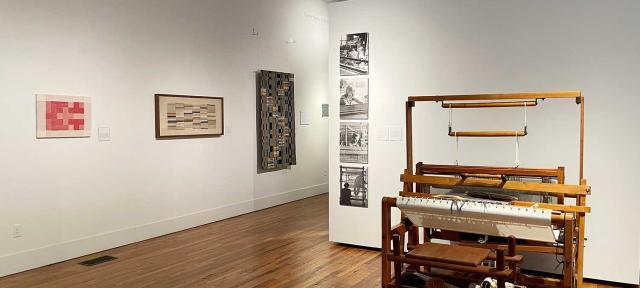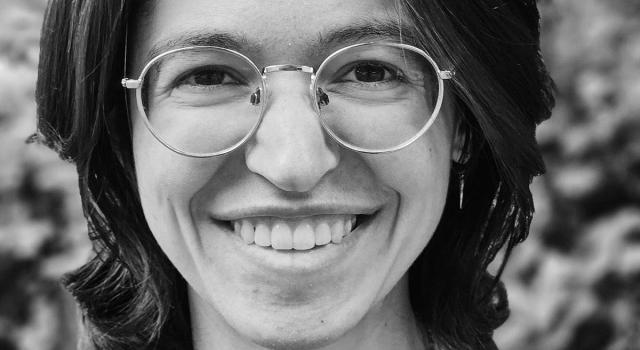Michael Beggs 07F Is Passionate About Doing For the Sake of Doing

Michael Beggs 07F is a proponent of experimental education, interdisciplinarity, and following his own questions, inspired by the pedagogy of both Hampshire and the former Black Mountain College.
Self-described “designer, weaver, artist, musician, teacher, and independent scholar” is has also worked in architecture and as a curator. We talked to him about his time at Hampshire and how it impacted the work he does now.
What did you come to Hampshire to study? Did that change while you were here?
When I first arrived, I was serious about music (I play the trumpet) and had done some filmmaking, so I thought I might study either of those. But gradually I came to understand that I was very interested in art and in the presentation of art — how curators, artistic directors, historians, and designers create the contexts in which we experience artworks in any medium.
As the son of two former architects, I viewed this initially as a design problem, but then I interned at the Art Institute of Chicago, and that experience showed me that curators, not exhibition designers, were really doing the role I was interested in. I also began to realize that I was interested in the art itself, so my Div III landed more in the realm of art history, though in an interdisciplinary way.
Tell us about your Div III, “Learning Art: Contemporary and Past Approaches to College Arts Education; Black Mountain College, Josef Albers, Color, and the Didactic Art Exhibit.”
It had three components: the largest was a 100-page paper about the interdisciplinary role of the arts in the curriculum at Black Mountain College, a legendary experimental liberal arts school that operated from 1933 to 1956. I also taught a class based on Josef Albers’s experiential method of exploring color, developed at Black Mountain College and later recorded in his 1963 book, Interaction of Color. Last, I curated an exhibition called Abstraction / Subtraction, which showed works from Hampshire’s own, little-known collection.
Were there particular professors who supported you?
I was blessed with great advisors all around. I owe a lot to Professor of Architectural and Art History Karen Koehler in particular. I took her class on the Bauhaus, and she arranged for me and another Hampshire student to travel to Germany as part of a student symposium about the Bauhaus. We were the only two Americans in an international group of ten. Going there gave me the opportunity to think of myself as a Bauhaus scholar, and I did an independent study with her the following semester on color theory at the Bauhaus.
Karen also suggested I contact the Josef and Anni Albers Foundation, in Connecticut, for a summer job, as both Alberses had been major figures at the Bauhaus, and she thought my expertise might be useful. I wound up working there during the summer between Div II and Div III, and then for four years after graduation. During that first summer, I fell in love with the work of both Josef Albers and Anni Albers and with Black Mountain College, and that experience deeply shaped my Div III and the years since.
Every Hampshire student is required at some time to have an opinion on how they themselves are going to learn, and I think being engaged in your own education in that way is essential to learning.
How did your experience at Hampshire influence your current work?
I’m now firmly embedded in the world of Black Mountain College scholarship and have written widely about various aspects of the school and its arts program, all of which feels somewhat contingent on whatever hunch inspired me to sign up for Karen’s Bauhaus class in the first place.
I’m a strong believer in experiential education, in the value of process over product, and in the importance of developing the self alongside developing skills. I would say broadly there’s insufficient concern in architecture schools about the personal growth and well-being of students. Perhaps because it’s a professional degree, students and teachers tend to focus on the transfer of skills, but I think we can do better.
There’s a growing recognition that there are long-ignored problems in our discipline about labor and overwork, about racial, class, and gender discrimination, and about the contribution of the building industry to climate change, and all of these issues require architects to be good people, for lack of a better term, in addition to being technically proficient. I think my point of view on education, on the methods of pedagogy and the structure of learning and development, comes directly out of my Hampshire experience. Every Hampshire student is required at some time to have an opinion on how they themselves are going to learn, and I think being engaged in your own education in that way is essential to learning.
How did Hampshire prepare you for grad school?
I got a master’s degree in architecture from the College of Environmental Design at UC, Berkeley, and doing self-guided learning at Hampshire was very helpful. It can be easy in an architecture program to work too long on a project and overshoot deadlines, because there are no right answers. You have to know when to stop, which requires knowing yourself and how you work best. I think the way in which Hampshire required me to be more responsible for my own learning really set me up well for that work.
In typical Hampshire fashion, I was also very eager to take any opportunity I could to follow my own interests, even when they weren’t officially supported in the curriculum. So, I wound up facilitating two experiential independent-study groups with my classmates as a way of exploring those interests. I also particularly loved doing thesis work, as it felt very familiar to have that freedom to identify a set of questions that interested me and then try to find some possible answers for them.
Are there specific projects you’ve worked on that were particularly satisfying?
Recently, I cocurated Weaving at Black Mountain College: Anni Albers, Trude Guermonprez, and Their Students, which was on exhibit in fall 2023 at the Black Mountain College Museum + Arts Center, in Asheville, North Carolina. This was the culmination of a four-year collaboration with fellow Black Mountain College scholar Julie J. Thomson. We also wrote a 200-page book of the same name. We did this in our spare time as independent curators, which I think is also indicative of the Black Mountain ethos, the idea and value of doing something for the sake of doing it. That’s an impulse that’s present at Hampshire, too.
What would you say to a prospective student?
R. Buckminster Fuller said, “Dare to be naïve.” It can feel tremendously exposing to try something new when you’re worried about how you appear while you’re doing it, especially in an intellectual or academic environment. Follow your interests wherever they lead you, and don’t get too preoccupied with whether or not you’re good at something until you’ve been doing it for a while. You’ll get to be good at something if you keep working at it, so the important thing is to try, not to be good. School is a time for experimentation!
Photo courtesy of Michael Beggs. Installation of Weaving at Black Mountain College: Anni Albers, Trude Guermonprez, and Their Students at the Black Mountain College Museum + Arts Center, Asheville, NC (September 29, 2023 - January 6, 2024).



